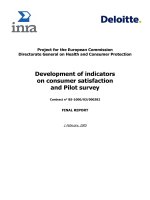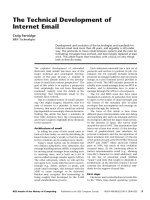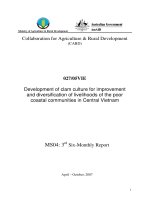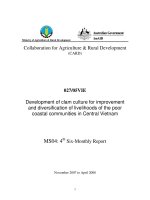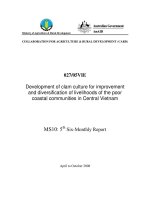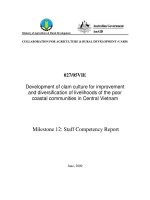Development of internet based remote maintenance and telemonitoring system
Bạn đang xem bản rút gọn của tài liệu. Xem và tải ngay bản đầy đủ của tài liệu tại đây (2.07 MB, 131 trang )
DEVELOPMENT OF INTERNET-BASED REMOTE
MAINTENANCE AND TELEMONITORING SYSTEM
CHENG YANG
(B.Eng., Huazhong University of Science & Technology, P.R.China)
A THESIS SUBMITTED
FOR THE DEGREE OF MASTER OF ENGINEERING
DEPARTMENT OF ELECTRICAL AND COMPUTER ENGINEERING
NATIONAL UNIVERSITY OF SINGAPORE
2004
Acknowledgments
I would like to take this opportunity to express my gratitude to my supervisor, Dr. Liu
Zhejie, for his invaluable assistance, guidance and encouragement throughout my
research and thesis work in National University of Singapore (NUS) and Data Storage
Institute (DSI).
My sincere thanks are extended to Dr. Jiang Quan, Dr. Feng Wei, Mr. Shen Zhenqun,
and Mr. Ong Chun Hwee for their help during the course of my research.
I would like to express my appreciation to NUS and DSI for granting me the Research
Scholarship, without which I could not have carried out my research work.
Finally, special thanks to my parents for their infinite support, encouragement and
understanding towards my studying abroad.
i
Table of Contents
Acknowledgments .......................................................................................................... i
Table of Contents ..........................................................................................................ii
List of Figures................................................................................................................ v
List of Tables ...............................................................................................................vii
Summary.....................................................................................................................viii
Chapter 1
Introduction........................................................................................... 1
1.1
Research Motivation ....................................................................................... 1
1.2
Research Objectives........................................................................................ 3
1.3
Structure of the Thesis .................................................................................... 4
Chapter 2
2.1
State of the Art ...................................................................................... 6
Trend of Remote maintenance ........................................................................ 6
2.1.1 Remote Maintenance Features and Scenarios............................................. 7
2.1.2 Benefits of Remote Maintenance.............................................................. 10
2.2
Internet-based Remote Maintenance............................................................. 13
2.3
e-Diagnostics in Semiconductor Manufacturing Industry ............................ 17
2.3.1 e-Diagnostics Definition in Semiconductor Manufacturing Industry....... 18
2.3.2 Reference Model for e-Diagnostics Capability Levels............................. 18
2.3.3 e-Diagnostics Solutions for Semiconductor Manufacturing..................... 20
2.4
Elements of Remote Maintenance System ................................................... 22
2.5
Summary and Discussion.............................................................................. 23
Chapter 3
Key Technologies and Methods ......................................................... 25
3.1
Client/Server and Multi-tier Architecture Model ......................................... 25
3.2
Distributed Object Technology..................................................................... 28
ii
3.3
.NET Remoting ............................................................................................. 30
3.3.1 .NET Remoting Overview ........................................................................ 30
3.3.2 General .NET Remoting Process .............................................................. 31
3.3.3 Channels and Formatters........................................................................... 33
3.4
Unified Modeling Language (UML) ............................................................ 35
3.5
Summary and Discussion.............................................................................. 37
Chapter 4
Remote Maintenance Using Remote Access ..................................... 38
4.1
Remote Access for Remote Maintenance ..................................................... 38
4.2
Remote Access Working Principle Using VNC ........................................... 39
4.3
Remote Maintenance Using UltraVNC ........................................................ 42
4.4
Solutions to Improve UltraVNC for Remote Maintenance .......................... 43
4.5
Summary and Discussion.............................................................................. 51
Chapter 5
Design of Remote Maintenance System ............................................ 54
5.1
System Requirement Analysis ...................................................................... 54
5.2
System Architecture Model .......................................................................... 56
5.3
Component Analysis and Design.................................................................. 60
5.3.1 System Component Overview .................................................................. 60
5.3.2 E-Maintenance Host Component.............................................................. 62
5.3.3 Local Equipment Host Component........................................................... 71
5.3.4 Remote Service Host Component............................................................. 73
5.4
Data Communication Links .......................................................................... 74
5.5
Message Flow Definition.............................................................................. 78
5.6
System Security ............................................................................................ 81
5.6.1 Security Model.......................................................................................... 82
5.6.2 Security Techniques.................................................................................. 83
iii
5.7
Summary and Discussion.............................................................................. 86
Chapter 6
6.1
Prototype Development and System Implementation ..................... 88
System Overview .......................................................................................... 88
6.1.1 The Stand-alone AIO Tester System ........................................................ 88
6.1.2 System Physical Configuration................................................................. 90
6.2
System Implementation and Integration ....................................................... 91
6.2.1 Customer Equipment Application and Supplier Service Application ...... 91
6.2.2 Server Objects Implementation................................................................. 91
6.2.3 On-line Text Chat ..................................................................................... 93
6.2.4 Synchronization ........................................................................................ 94
6.2.5 Priority-based Message Scheduling.......................................................... 95
6.3
Prototype Setup and Testing ......................................................................... 98
6.4
Summary and Discussion............................................................................ 102
Chapter 7
Conclusion ......................................................................................... 103
References.................................................................................................................. 107
Appendices................................................................................................................. 116
iv
List of Figures
Figure 2.1 Basic function model of digitized teleservice system (from [13]) ................ 8
Figure 2.2 ISMT e-Diagnostics Capability Levels (from [36]) .................................... 19
Figure 3.1 From Two-tier to Multi-tier Architecture.................................................... 27
Figure 3.2 General .NET Remoting process................................................................. 32
Figure 3.3 .NET Remoting over HTTP Channel (from [64]) ....................................... 34
Figure 3.4 .NET Remoting over TCP Channel (from [64]).......................................... 34
Figure 3.5 Symbols of Boundary, Control and Entity Classes (from [38]) .................. 36
Figure 4.1 VNC Working Behavior (from [72])........................................................... 40
Figure 4.2 UltraVNC Architecture ............................................................................... 41
Figure 4.3 Modified System Architecture of VNC for Remote Access ....................... 44
Figure 4.4 Modified UltraVNC with Single Application Window and File Transfer .. 46
Figure 4.5 View-in-Viewer for UltraVNC.................................................................... 47
Figure 4.6 HTTP Tunneling for UltraVNC .................................................................. 49
Figure 4.7 Start Procedure for Video Monitoring Function ......................................... 50
Figure 4.8 Integration of Video Monitoring and Equipment Application .................... 51
Figure 5.1 Hardware Architecture ................................................................................ 57
Figure 5.2 Block Diagram of System Component Architecture................................... 60
Figure 5.3 Three-layer Service Architecture ................................................................ 61
Figure 5.4 e-Maintenance Server Host Component Model .......................................... 63
Figure 5.5 Use Case Diagram for e-Maintenance Server Component.......................... 64
Figure 5.6 Sequence Diagram for Register Remote Object.......................................... 65
Figure 5.7 Sequence Diagram for Use Security Mechanism........................................ 66
Figure 5.8 Sequence Diagram for Send Control Command ......................................... 67
v
Figure 5.9 Sequence Diagram for Retrieve Control Command.................................... 67
Figure 5.10 Sequence Diagram for Send Run-time Data ............................................. 68
Figure 5.11 Sequence Diagram for Retrieve Run-time Data........................................ 68
Figure 5.12 Sequence Diagram for File Operation....................................................... 69
Figure 5.13 Sequence Diagram for Remote Service Host Join Session ....................... 70
Figure 5.14 Session Management ................................................................................. 71
Figure 5.15 Local Equipment Host Component Model................................................ 72
Figure 5.16 Remote Service Host Component Model .................................................. 74
Figure 5.17 System Data Communication Links.......................................................... 75
Figure 5.18 Message Flow for Remote Monitoring...................................................... 79
Figure 5.19 Message Flow for Remote Control............................................................ 80
Figure 5.20 Message Flow for Remote Diagnostics..................................................... 81
Figure 5.21 System Security Model.............................................................................. 82
Figure 5.22 Two-step Authentication and Authorization ............................................. 84
Figure 6.1 Hardware for AIO Tester System................................................................ 89
Figure 6.2 Software Architecture for AIO Tester System ........................................... 89
Figure 6.3 System Physical Configuration ................................................................... 90
Figure 6.4 Data Buffer Queue on the Server ................................................................ 92
Figure 6.5 Integration of On-line Chat with Supplier Application............................... 94
Figure 6.6 Synchronization of AIO Tester Parameter Setup for Supplier Application 95
Figure 6.7 Time Line for Sending Thread and Retrieving Thread ............................... 97
Figure 6.8 Spindle Motor Parameter Setting .............................................................. 100
Figure 6.9 Spindle Motor Dynamic Speed Testing .................................................... 100
Figure 6.10 Spindle Motor Starting Current Testing .................................................. 101
Figure 6.11 Spindle Motor File Access ...................................................................... 101
vi
List of Tables
Table 2.1 Benefits of remote maintenance for supplier and customer (from [10]) ...... 12
Table 6.1 Differences between Control Command and Monitoring Data .................... 96
Table 6.2 Configurations of Three Computers ............................................................. 98
vii
Summary
This thesis reports the current research in the area of Internet-based remote
maintenance. Internet and distributed object technologies are utilized in the design,
development, and implementation of the Internet-based remote maintenance system. In
the former Internet-based remote maintenance systems, remote connectivity, system
architecture, and system security are not addressed systematically. However, they are
key and crucial issues in an Internet-based remote maintenance system. This research
aims to identify and propose effective solutions to address these issues. In particular, a
three-layer architecture for Internet-based remote maintenance across enterprise
boundaries is devised and developed.
Through literature reviews of relevant research, Internet-based remote maintenance
scenarios, benefits, and elements are identified and analyzed systematically. Internet
and distributed object technologies are examined and .NET Remoting is chosen as the
basis for system design and implementation due to its advantages in terms of
connectivity, interoperability and maintainability.
Effective solutions for two major maintenance scenarios are presented respectively. An
open source software package for remote access by sharing application Graphic User
Interface (GUI) using Virtual Network Computing (VNC) is employed to facilitate
remote maintenance for customer training and product demonstration. Regarding key
issues for Internet-based remote maintenance, solutions are proposed and implemented
by modifying the VNC software package to cater to the requirements. As far as the
direct equipment data transfer is required, system architecture is constructed by using
client/server and three-layer architecture model. Three hosts being supplier service
viii
host, customer equipment host and e-Maintenance server host are devised. Data
communication links and message flow definition among the three hosts are designed
as well. Furthermore, a system security model is built and effective techniques are
taken to improve the security of the system.
An Internet-based remote maintenance prototype system for the on-line quality control
of the high precision spindle motor has been successfully developed and tested. The
system is built upon the .NET framework. System implementation and component
integration are discussed as well. Testing results show that this prototype is effective in
conducting remote maintenance over the Internet.
With the developed system, further functional development, extension, and integration
for the remote maintenance system can be readily carried out.
ix
Chapter 1
Introduction
1.1 Research Motivation
In today’s e-Manufacturing era, it is a prerequisite for a company to compete with its
quality products as well as quality services in the global marketplace. After-market
service and maintenance of products are becoming extremely important for a company
to pursue the most advanced manufacturing productivity and customer’s satisfaction in
the highly competitive modern market. This competition in the manufacturing industry
depends not only on manufacturing technologies, but also on the ability to provide
customers with services and life-cycle costs for sustainable value [1].
However, traditional service relying solely on onsite field engineers is unsatisfactory
due to its inherent high cost and low efficiency. The expense for dispatching highly
trained service experts to the customer’s site can be very costly for not only suppliers
but also customers, because the necessary time for traveling may prolong equipment
downtime, leading to significant production loss. Therefore, it is necessary to seek and
provide a faster, more efficient and less expensive after-market service to support
manufacturing and testing equipments.
The advantages of remote maintenance are apparent, as such a system allows the
equipment supplier to support its customers more efficiently by using state-of-the-art
information technologies to ensure consistent product quality. As a result,
1
manufacturing activities could be integrated and monitored in many regions and
countries. In addition, information on productivity, diagnostics, and training of
manufacturing systems could be shared among different locations and partners [2].
Furthermore, remote monitoring, diagnostics and operation, which allow supplier’s
service experts to obtain the health conditions of the equipment timely, can minimize
Mean Time to Repair (MTTR), improve Overall Equipment Effectiveness (OEE) and
greatly reduce on-site service costs.
With the rapid proliferation of Internet communication technologies, accessing and
operating remote equipments over the Internet is becoming a reality. The collaborative
communication and remote control capability enabled by Internet infrastructure is to
provide a very powerful and desirable way for testing, monitoring, controlling and
maintaining equipments remotely across the enterprise boundaries.
Internet technologies, such as client/server and multi-tier architecture model, and
distributed object technologies, can play a key role in e-Manufacturing as well as
remote maintenance to allow the transfer of equipment information over the Intranet or
Internet connections [3][4][5][6]. Equipment manufacturers and software developers
must embrace a standard form of distributed object computing that will meet the
industry's needs to manage process controls and to detect faults in real or near-real
time [7]. Up to very recently, three distributed object technologies, namely Distributed
Component Object Model (DCOM), Common Object Request Broker Architecture
(CORBA) and Remote Method Invocation (RMI), are widely used in the industry.
However, these technologies have more or less some shortcomings, such as
interoperability with other distributed object technologies and inconvenience to work
2
in an Internet environment. Shortcomings in nature degrade the pervasive and efficient
use of these distributed object technologies in an Internet environment.
As a new generation of distributed object technology, .NET Remoting reveals its
superiority over previous ones. It eliminates the faults of DCOM, CORBA and RMI by
supporting various transport protocol formats and communication protocols. It can run
under an Internet environment easily by using common Internet communication
protocols, such as Hypertext Transfer Protocol (HTTP) and Transfer Control Protocol
(TCP). Furthermore, it has the ability to interoperate with other platforms by using
various formatters to serialize messages. This allows .NET Remoting to be adaptable
to the network environment in which it is used, whether it is Intranet or Internet.
Therefore, .NET Remoting enables remote maintenance over the Internet for factory
and plant equipments.
1.2 Research Objectives
The challenge of providing remote maintenance services requires the efforts from both
the equipment supplier and its customer. Moreover, modern equipments are becoming
more and more complicated and they may run on heterogeneous systems and platforms.
Therefore, this thesis is aimed to design and develop an Internet-based remote
maintenance system to realize remote monitoring, operation and diagnostics of
equipments by using the Internet and distributed object technologies. In order to
achieve this aim, the objectives of this thesis are described as follows:
y
Identify issues in the area of Internet-based remote maintenance.
3
y
Investigate and examine enabling technologies and methods to design,
develop, and implement remote maintenance system.
y
Employ the advanced distributed object technology and methods to design
and develop a generic architecture for Internet-based remote maintenance
system.
y
Build a prototype system to demonstrate the proof-of-concept and apply the
generic system to the remote maintenance of a spindle motor tester used in
data storage industry.
1.3 Structure of the Thesis
This thesis is organized as follows:
Chapter 2 reviews the current research status in the area of remote maintenance via the
Internet. The features, various scenarios and benefits of remote maintenance are
presented. In particular, e-Diagnostics in semiconductor manufacturing is discussed.
Finally, elements of a remote maintenance solution are further identified and discussed.
Chapter 3 presents the most relevant and key technologies and methods applied in this
research work. The client/server and multi-tier architecture model, distributed object
technologies, .NET Remoting and Unified Modeling Language (UML) are discussed.
Chapter 4 presents a solution for remote maintenance by using remote access
technique. As a typical representative of remote access solution, the working principle
of Virtual Network Computing (VNC) is discussed. In addition, various advantages
4
and disadvantages of using UltraVNC for remote maintenance are identified. Possible
solutions are provided to enhance the use of UltraVNC for remote maintenance.
Chapter 5 proposes an alternative solution for remote maintenance via the Internet.
The system requirements are analyzed first and the system architecture is devised.
Various components, data communication links and message flows are analyzed and
designed. Particularly, system security for the remote maintenance system is discussed
and possible techniques are adopted to ensure the security of the system.
Chapter 6 outlines the description of the remote maintenance architecture presented in
chapter 5 for implementing a prototype system as the proof-of-concept. The system
overview, system implementation and integration, and the prototype setup are given in
this chapter.
Chapter 7 summarizes the key results of the presented work, and indicates the possible
future research and development work in this area.
5
Chapter 2
State of the Art
The idea of remote maintenance is not new in various industries. However, in recent
years, this topic has been given more and more attention with the coming of the eManufacturing age. This chapter will discuss the trend, scenarios as well as benefits of
remote maintenance for both equipment supplier and customer. Next, some Internetbased remote maintenance systems and applications are presented. e-Diagnostics with
its definition, reference model and typical implementations in the semiconductor
manufacturing industry are described. Finally, elements of a general remote
maintenance system are identified and discussed.
2.1 Trend of Remote maintenance
Service and maintenance are becoming extremely important practices in new internal
and external enterprise networks to maintain productivity, customer satisfaction,
optimal rate for component operation, and to support after-market phases [8].
Increased globalization of business and manufacturing activities has placed increased
demands on equipment suppliers for service and support at locations far from their
home offices and service facilities. This trend calls for increased investment in the
training of local service and user personnel, duplication of specialized equipment for
servicing and maintenance, and additional travel costs associated with service,
6
maintenance and training. These expenses are frequent obstacles in the international
marketing for small and medium sized enterprises [9].
Another factor behind the rapid rise in the importance of service and maintenance is
the pace at which the complexity of plants and machinery has been increasing. That
pace has been significantly accelerated by the growing use of mechatronic systems.
Mechatronics is characterized by an integrated, interdisciplinary approach to project
planning, design and development of complex multi-technical equipments, systems
and plants. Quite often, mechatronic equipments, systems and plants can only be
installed and operated in conjunction with support services, because they require
specialist know-how and , in the case of faults or repairs, skilled customer support by
the manufacturer’s specialists [10]. Therefore, increasing demands placed on the
availability of machines, international competition, complex products and functions,
efficient personnel planning and product liability call for new service strategies. This
kind of service features lifecycle support as well as process support and function
oriented customer support. Integration of technologies in terms of information
technology and industrial technology enables the manufacturers as well as the
customer to implement new functionalities in machines and processes [11].
2.1.1
Remote Maintenance Features and Scenarios
One basic approach which can alleviate the above problems and support these
maintenance requirements and practices is remote maintenance, telemaintenance or
teleservice. Teleservice is described as a service that enables all customer contacts in
connection with the planning, installation and operation of plants and machinery to be
carried out more simply, more cost-efficiently, faster, and from any place using
7
modern communication and information technologies, combined with multimedia
tools [10].
In the manufacturing domain, teleservice is characterized by using three main criteria
[12]:
y
Geographical distance between the customer and the supplier. It implies that a
supplier who is spatially separated from the customer provides the service.
y
Use of information technology required to carry out the service in terms of remote
information processing, storing and communication.
y
Industrial service. The services have to be in the field of industrial services (e.g.
maintenance, diagnosis, monitoring, etc.)
The basic functions of teleservice system are discussed in [13]. These functions
include online-support, advanced and overall training, process support, diagnosis of
equipment malfunction, etc. Based on these functions, the function model of the
digitized teleservice system is presented in Figure 2.1.
Internet/
Intranet
debug
Supplier
Customer
spare
products
training
engineering
support
process
support
maintenance/
repairing
Figure 2.1 Basic function model of digitized teleservice system (from [13])
8
Therefore, the scenarios of teleservice or remote maintenance can be any one or a
combination of the following:
y
Debugging and initializing work of equipment
When equipment is first shipped to the customer’s side, debugging and initializing
work are needed for the configuration and setting up of equipment parameters before
the equipment starts to work. This support allows customer to deploy equipment
rapidly and easily without supplier service personnel on the customer’s side. This kind
of remote maintenance support does not need equipment and process related
information since the equipment is still in the preparing stage. The only requirement is
that the supplier can connect and transfer information to the equipment remotely.
y
Training of local customer service and user personnel to use equipment
Customer training is to ensure service personnel or new operator at the customer side
to understand the complex equipment or system rapidly and efficiently improve
production rate. The supplier can teach them how to use the software and operate the
equipment. Demonstration can be conducted to show how equipment works and some
other information required to be noticed during equipment operation. Additionally, the
supplier can share the Graphic User Interface (GUI) of the software with the customer
operators to teach them how to use it.
y
Diagnosis of equipment malfunction
It is feasible to diagnose a malfunction timely and efficiently, to maintain and repair
equipment quickly, to shorten equipment downtime, and to restart production rapidly
by conveying special information about the condition of equipments or machines to
9
manufacturers or special service mechanism. In this kind of remote maintenance,
equipment condition information can be collected, monitored, and analyzed remotely.
Then, a solution to this malfunction will be produced and forwarded to the customer to
solve this problem.
y
Manufacturing process support
Often, the manufacturing process can be supported by the equipment supplier. In this
case, the equipment customer should provide related production data to its supplier to
control and monitor the process as well as production quality. Process support is
especially aimed at problems of complex production by complex equipment. So
customers can give full play to the ability of the equipments and machines and shorten
time of feedback.
From the above analysis, remote maintenance can be generally categorized into two
groups: with data support and without data support, according to the sharing of
equipment
or
process
data
between
customer
and
supplier.
Equipment
debug/initialization and customer personnel training can be performed remotely
without detailed equipment or process data support. However, in order to diagnose and
fix equipment remotely, the supplier needs necessary equipment or process data to
speed up malfunction detection and problem solving.
2.1.2
Benefits of Remote Maintenance
In today’s industrial environment, the equipment used has become increasingly
complex and specialized. As a result, much expert knowledge is required not only of
the process it is used for, but also of the equipment itself. It is typically not possible for
one organization to have all of this expertise, let alone have it at every physical
10
location it is required. A remote maintenance and customer support system which
deals efficiently with remote operations can benefit both the supplier, who can expand
their business into the global market, and the customer, who wishes to avoid
productivity losses due to equipment downtime. Therefore, at least three parties benefit
from remote maintenance – equipment supplier, service departments and maintenance
personnel, and customer [14].
Remote maintenance enables the equipment supplier to design his services more
effectively. With the right data available to the right service expert, the problem could
often be solved remotely. Accordingly, time-consuming traveling by service experts to
the customer can be reduced. Even if travel is inevitable, the right service expert can be
dispatched with necessary parts and tools because the equipment information has been
retrieved in advance. At the same time, communication between the supplier and the
customer is improved. This helps to reduce service costs while increasing the
availability of systems. Moreover, data on customer issues and solutions can be
utilized to drive future equipment developments. At last, remote maintenance positions
the equipment supplier to provide value-added services, which allow production,
assembly and fault elimination as well as autonomous fault compensating process
regulation [15].
For the equipment customer, downtime of the equipment can be shortened by means of
remote maintenance since maintenance work, remote diagnosis and fault elimination
can be carried out. With a remote maintenance system, time is saved by notification to
the supplier, which in turn begins to work on the problem remotely. In particular, there
is no long period waiting for the service experts to arrive. By continuous data
collection, monitoring, and analysis for the service experts, preventing failures
11
becomes a reality. Additionally, preventative maintenance can now be selectively
scheduled to when it is convenient for the end user.
Table 2.1 summarizes the benefits of remote maintenance for both the equipment
supplier and the customer.
Table 2.1 Benefits of remote maintenance for supplier and customer (from [10])
Supplier Side
Customer Side
Cost reduction (personnel and travel Long-term
expenses)
Increased
of
operating
expenses
availability
of
specialists
within own company
If necessary, the right specialist can be
sent to the customer’s site
of
Increased availability of plant
service
expense
beyond
warranty
Improvements to service efficiency
transparency
Reduction of machine down-time
Minimal
Optimization of service structures
Greater
reduction
Support during commissioning phase
service Individual
support
with
process
procedures
implementation and modification
Customer ties are intensified
Simple uploading of software updates
Enhancement of in-house competence to
Competitive leads are generated
solve problems
Increased satisfaction of employees by
Presence in distant economic regions
expanding the knowledge base and
broadening the range of tasks performed
Increased level of service performance
External training of employees
Reduction in response time
Greater focus on supplier company
More detailed information on plant
disruptions
are
used
to
achieve
continuous improvement
12
2.2 Internet-based Remote Maintenance
The main idea of the remote maintenance is that it is easier to transfer information,
system and environment knowledge to different specialists such that they could
interoperate together through remote exchanges rather than to move the specialists to
sites where information and knowledge are available. This remote interaction between
the supplier and its customer leads to situation analysis, decision-making
implementation and, sometimes, actions.
Remote maintenance by telephone is not always satisfied because the data related to
the malfunction cannot be obtained by the supplier easily. To communicate a defect,
the customer must describe the symptom in great detail verbally. The ambiguity of
natural language becomes even more of an obstacle when one or both parties must use
a foreign language. Traditional maintenance methods are also unsuitable for correcting
another possible cause of malfunction – an incorrect instrument parameter setting. In
this situation, the equipment appears to be malfunctioning because some sequence of
actions has caused it to reach an inappropriate combination of instrument parameters.
In the traditional mode of maintenance, the customer must produce an exhaustive list
of equipment-setting parameters, which is time-consuming [16].
The Internet and its current infrastructure provide many opportunities to exploit
improved electronics testing by increasing collaboration among individuals worldwide.
There are several ways available to take advantage of the ubiquitous Internet
infrastructure, its applications, and increasing network bandwidth to better share
knowledge between engineering and test technicians, and to build and maintain a
network of knowledge sharing among test and maintenance technicians in
13
geographically separated units. Current Internet infrastructure applications that are
available and being used in an ad hoc manner are email, instant messaging, video
conferencing, and remote control of PCs. These applications can be used to integrate
and enhance communication methods and to improve the sharing of data as well as
remote control of automatic test equipment by engineers providing diagnostic
assistance. Therefore, collection of repair and test data in real-time from
geographically dispersed locations can be implemented via the Internet [17].
With the rapid development of the Internet and information technologies, some
industries have developed their own remote maintenance systems in recent years and
these systems have been applied in different industries. Typical examples of these
systems are briefly described as follows.
1. A remote maintenance system for the food processing industry [9]. The system
uses commercially available technologies for remote maintenance. It is
assumed that in addition to data channels for equipment monitoring and
adjustments,
a
bidirectional
audio
channel
is
provided
for
verbal
communication with the user. However, this system has the shortcoming of
limited connectivity because dedicated Integrated Services Digital Network
(ISDN) or modem connections over the telecom network are used as the
communication channels.
2. A remote operation system for the mineral and metal processing industry [18].
The system comprises of software modules in the analyzer operating station
end and in the remote expert station end. By using separate interface
components for data communication, a modular software structure has been
obtained. Modularity helps in developing and maintaining the tools in the
14
future. However, this system relies on Virtual Private Network (VPN), which
requires network reconfiguration in a customer site. Furthermore, the TCP
protocol is not so firewall-friendly, which limits the usage of the system in an
Internet environment.
3. A distributed maintenance system used by the manufacturer to provide
maintenance-related information to their own service technicians and their
customers over the Internet [19]. The goal is to enable the user to call for the
data he needs in an easy way, independent of location and time. However,
limited functions are provided in this system. Users can only access the static
equipment data manually through the World Wide Web and this system lacks
online interaction between suppliers and customers.
4. Remote Diagnostics Server Framework [20]. This system is applied to the
remote diagnostics and health monitoring of mission critical systems such as
the International Space Station, nuclear power plants or space shuttles. The
framework is built on the three-tier architecture with a “Broker” application in
the middle layer, which connects both client and server through a messagepassing network, such as the Internet. The client layer consists of sensor agents
that collect test results and transmit them over a network, or to technicians with
web browsers being guided through intelligent troubleshooting sessions. A
database in the backend is used to manage models and content, and collect
diagnosis logs for data mining.
5. Remote Drive Condition Monitoring [21]. This remote diagnostics system is
developed for the electrical drive system used in the cement industry. The drive
system is connected to a Personal Computer (PC) using a RS232 serial port,
with the PC connected to the telephone network or Internet through a modem.
15
